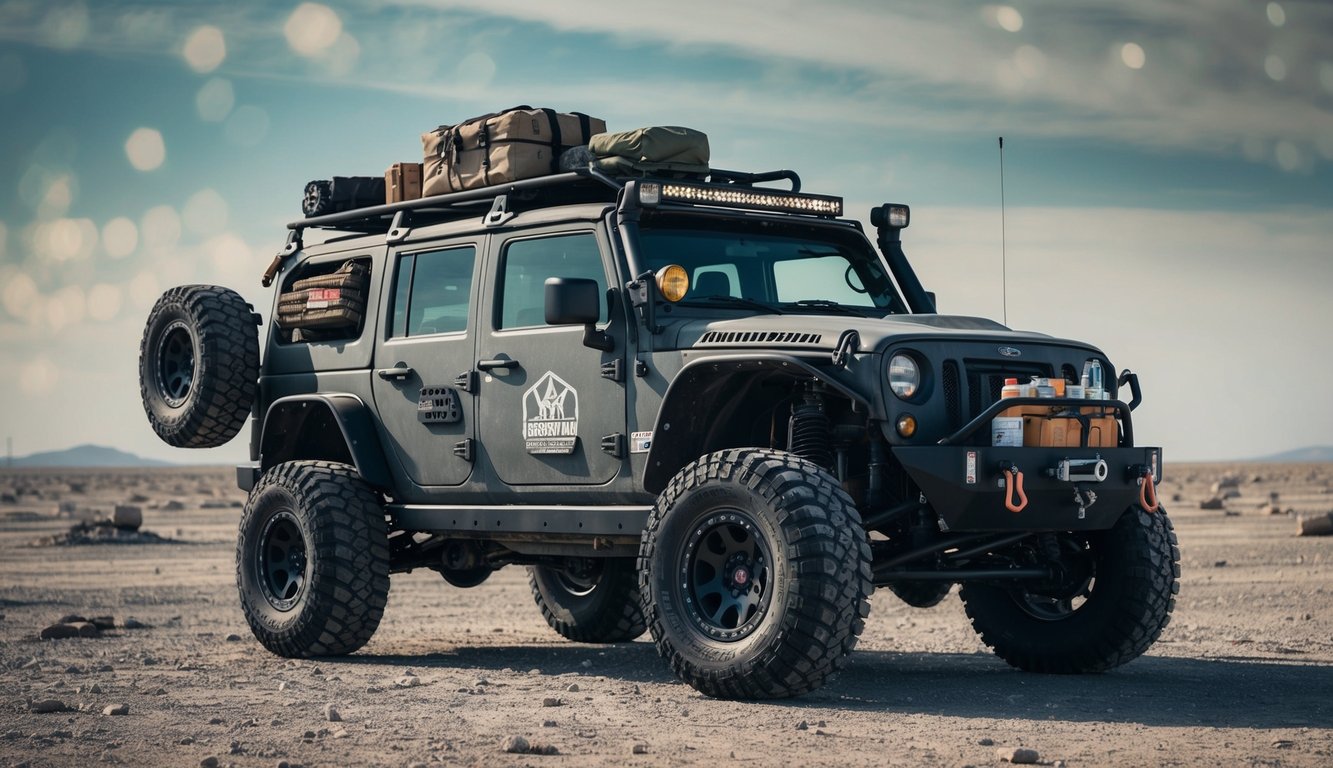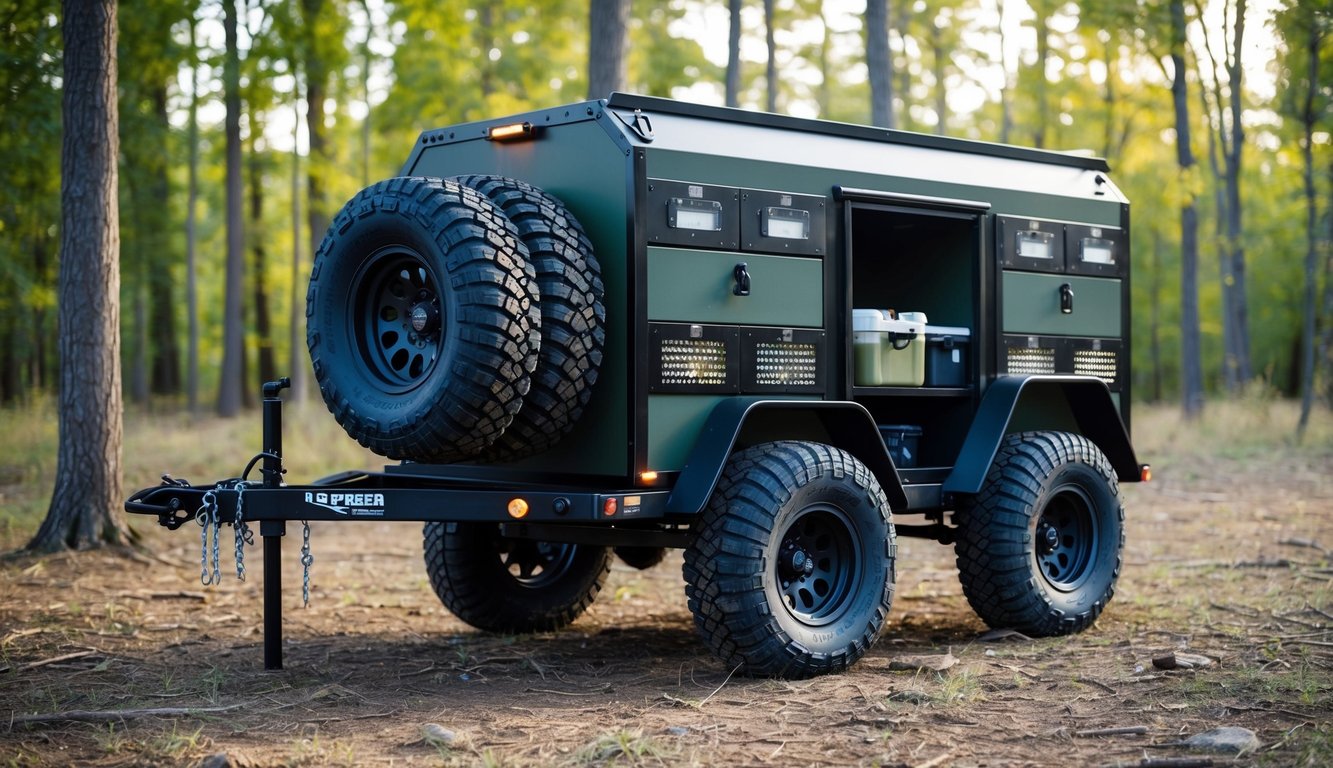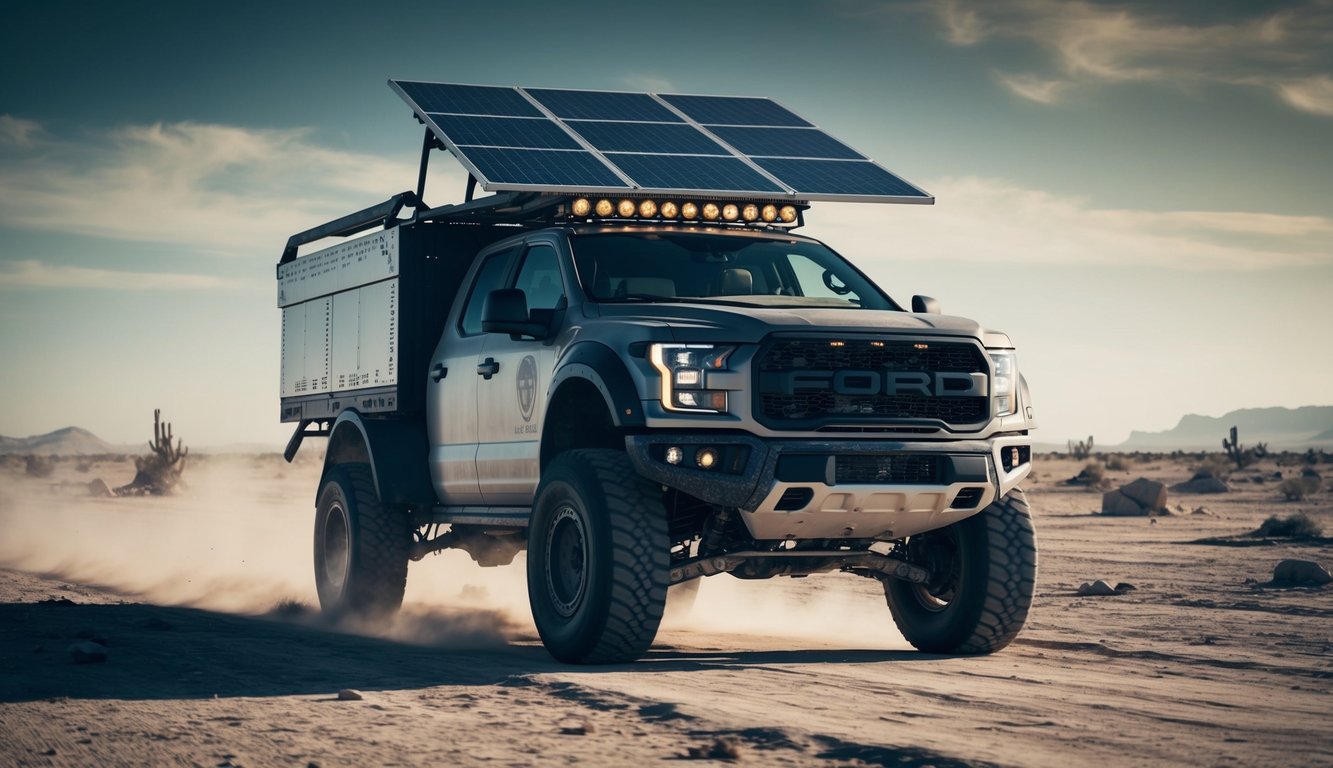Bug Out Vehicle: Essential Features for Your Emergency Escape Plan

Bug out vehicles are essential tools for emergency preparedness. These specialized vehicles help people quickly leave dangerous areas during disasters or crises. They come in many forms, from rugged off-road trucks to modified family cars.
The best bug out vehicles have key features like ample storage, sturdy construction, and the ability to handle rough terrain. Many preppers customize their vehicles with extra gear and supplies. While some opt for high-end custom rigs, even basic cars can work well with the right planning and equipment. The goal is to have a reliable way to reach safety when normal transportation breaks down due to natural disasters, social unrest, or other SHTF scenarios.
What's a Getaway Ride for Emergencies?
Key Parts of a Getaway Ride
A getaway ride for emergencies is a special vehicle made to help people leave fast when big problems happen. These rides are tough and can go many places. They're not like normal cars.
These vehicles have lots of room inside. People can pack them with important stuff like:
- Food and water
- First aid kits
- Tools
- Blankets
- Clothes
The ride needs to be strong. It should work even if things get rough. Good tires and a strong engine are a must. The car should be able to drive on:
- Dirt roads
- Muddy paths
- Rocky areas
Many people pick big trucks or SUVs as their getaway rides. These cars can go off-road and carry lots of gear. Some folks change their cars to make them even better for emergencies.
A good getaway ride should also:
- Have extra fuel tanks
- Use less gas
- Be easy to fix
- Have space for sleeping
It's smart to keep the ride ready all the time. This means checking it often and fixing any problems fast. Having a backup plan is also a good idea, like a second car or a bike.
Top Survival Vehicles
Rugged SUVs
SUVs are great picks for getting out of danger. They have lots of room for gear and can handle rough roads. Many SUVs come with four-wheel drive, which helps in tricky spots. The Jeep Wrangler is a top choice. It can drive through water up to 33 inches deep and has 12.9 inches of ground clearance. This makes it perfect for crossing streams or driving over big rocks.
Tough Trucks
Pickup trucks are strong and can carry heavy loads. They're good for pulling trailers too. The Toyota Tacoma is known for lasting a long time. It can go off-road and has a big bed for supplies. The Ford F-150 is another solid pick. It's tough and can tow up to 14,000 pounds.
Spacious Vans
Vans have lots of room inside. This makes them good for carrying people and stuff. Some vans can go off-road too. A 4x4 van with a roof rack can be very useful. You can store gear on top and still have space inside for sleeping.
Mobile RVs
RVs are like houses on wheels. They have beds, kitchens, and bathrooms built in. This means you can live in them while on the move. The EarthRoamer LTi is a luxury RV built for tough conditions. It's based on a Ford truck and can go far off-road.
| Vehicle Type | Pros | Cons |
|---|---|---|
| SUVs | Good off-road, roomy | Uses more gas |
| Trucks | Strong, can tow | Less inside space |
| Vans | Lots of inside room | Not all are 4x4 |
| RVs | Has living space | Big, hard to hide |
Important Vehicle Supplies for Emergencies
Car-Specific Items
A well-stocked vehicle should have tools for basic repairs and safety. Some key items include:
- Tool kit with wrenches, pliers, and sockets
- Jack and spare tire
- Jumper cables
- Tow strap rated for your vehicle's weight
- Gas can (empty or full)
- Tire inflator/compressor
- Window breaker and seatbelt cutter tool
Keep supplies tailored to your specific vehicle. Know how to use these tools before an emergency happens.
Drinking Water and Food
Pack enough water and non-perishable food for at least 3 days:
- Water bottles or jugs (1 gallon per person per day)
- Water filter or purification tablets
- Canned foods with long shelf life
- Energy bars or dried meals
- Manual can opener
Food and water are heavy but critical. Rotate supplies regularly to keep them fresh.
Ways to Get Help
Reliable communication is key in emergencies. Include:
- Car phone charger
- Battery pack for devices
- Weather radio
- Signal flares or reflective triangle
- Whistle
A working phone can be a lifeline. Make sure you can keep it charged.
Key Papers and Maps
Pack important documents and navigation aids:
- Printed maps of your area
- Compass
- Emergency contact list
- Copies of ID and insurance cards
- Cash in small bills
- Pen and notepad
Don't rely only on GPS. Physical maps and a compass are backups.
Protection from Weather
Your car provides some shelter, but pack extra items:
- Blankets
- Rain ponchos
- Change of clothes
- Sturdy boots
- Gloves and hats
Staying dry and warm is vital for safety. Layer clothing as needed.
Fire and Other Essentials
Basic fire-starting and survival gear includes:
- Matches in waterproof container
- Lighter
- Flashlight and extra batteries
- Multi-tool
- Duct tape
- First aid kit
- Trash bags
A lighter or matches can provide warmth and signal for help.
Having these supplies ready can make a big difference in an emergency. Pack what fits your needs and vehicle size. Check and update your kit regularly. Stay safe on the road!
Extra Supplies

A bug out vehicle needs more than just basic gear. Packing extra kits can boost readiness. These include:
- Bug out bags
- First aid supplies
- Car survival tools
Each kit adds important items for different situations. Having them ready in the vehicle improves chances of making it through tough times.
Unusual Bug Out Vehicle Options

Some preppers consider less common transportation choices for emergency situations. These alternatives can be useful in specific scenarios.
Aircraft provide quick travel to distant locations. They're expensive but fast. Boats offer another option for those near water. Houseboats can serve as floating shelters. Inflatable or foldable boats are portable choices for water travel.
Bicycles work well in urban areas or after power outages. They can go where cars can't and don't need fuel. Bike trailers let you carry extra gear.
Some people look at military vehicles. These are tough and can handle rough terrain. Examples include Humvees and MRAPs.
Motorcycles are popular with some preppers. Older models with carburetors may still run after an electromagnetic pulse. Bikes can weave through stalled traffic.
Regular cars aren't ideal but can work if that's all you have. Sedans might not be as capable off-road but can still get you from point A to B.
Mountain bikes offer a mix of urban and off-road ability. They're good for trails and can carry gear with the right setup.
Here's a quick comparison of some unusual bug out vehicles:
| Vehicle Type | Pros | Cons |
|---|---|---|
| Aircraft | Very fast | Very expensive |
| Boat | Good near water | Limited to waterways |
| Bicycle | No fuel needed | Limited cargo space |
| Military Vehicle | Very durable | High fuel use |
| Motorcycle | Fuel efficient | Less protection |
Each option has trade-offs. The best choice depends on your location, budget, and specific needs in an emergency.
Towing Your Emergency Gear

Bug out trailers offer a smart way to store and transport emergency supplies. These trailers attach to a vehicle when needed, keeping gear ready to go at a moment's notice. This setup allows for quick departures in urgent situations.
Trailers have some key benefits:
• Pre-packed with supplies
• Easy to hook up and go
• Keeps main vehicle uncluttered
• Stores more gear than a car alone
Many preppers find trailers practical. They can load up survival items ahead of time and leave them packed. When an emergency hits, they simply connect the trailer and drive off. This saves precious time during a crisis.
Using a separate trailer also keeps the primary vehicle free for daily use. There's no need to empty out supplies for regular errands. The trailer sits ready while the car stays functional for everyday life.
Electric Vehicles for Bugging Out

Electric vehicles (EVs) are gaining attention as potential bug out options. While they have some limitations, they also offer unique advantages for emergency situations.
Range and off-road capabilities can be concerns with EVs. However, their ability to serve as large mobile battery packs is a major plus. Many EV models can power various devices when put into special modes designed for camping or emergencies.
Charging flexibility is another benefit of EVs. They can be powered up using:
- Solar panels
- Generators
- Standard electrical outlets
This versatility makes finding power sources easier compared to relying solely on gasoline or diesel.
Some drawbacks to consider:
- Manufacturers may void warranties if EVs are used as stationary power sources
- EVs are vulnerable to electromagnetic pulse (EMP) events
For those worried about EMPs, building a large Faraday cage to protect an EV is possible but can be expensive. The materials alone may cost $1,000 or more.
Despite the challenges, EVs remain an interesting option to explore for emergency preparedness. Their dual function as both transportation and a mobile power source makes them worth considering as part of a comprehensive bug out plan.
EMP-Proof Bug Out Vehicles

Electromagnetic pulse (EMP) threats pose a risk to modern vehicles. Cars made after the 1980s have sensitive electronics that could be damaged by an EMP. Older vehicles are less likely to be affected, but are not guaranteed to work after an EMP event.
The best way to protect a vehicle from an EMP is to store it in a Faraday cage. This could be a specially built garage or a large bag that fits over the entire car. These options are expensive, with materials for a Faraday bag costing around $1,000.
Some vehicles are better suited for post-EMP scenarios:
- Commercial Utility Cargo Vehicles (CUCVs)
- Diesel-powered trucks
- Pre-1980s vehicles
CUCVs used by the military are designed to withstand harsh conditions. Some models have built-in EMP protection. Diesel engines are less reliant on electronics, making them a good choice. Vehicles made before 1980 have fewer electronic components and may be less vulnerable to EMP damage.
Popular EMP-resistant vehicle options:
- Jeep Wrangler
- Ford F-750 (base for EarthRoamer XV HD)
- Range Rover
- Can-Am Renegade X XC 1000R (ATV)
These vehicles offer good off-road capability and ruggedness. The EarthRoamer XV HD, built on a Ford F-750 chassis, is a luxury option with ample cargo space and strong all-terrain performance.
It's important to note that products claiming to protect vehicles from EMPs, such as EMP Shield and T.R.A.P. EMP Vehicle Protection, are not proven effective against nuclear EMPs. The intense voltage created by a nuclear EMP would likely overwhelm these devices.
In a real EMP scenario, the best strategy is to avoid exposure altogether. If possible, keep your bug out vehicle in a protected space or have backup transportation options that don't rely on electronics.
Remember that an EMP event could be a sign of larger problems. It's wise to have a comprehensive emergency plan that goes beyond just vehicle preparedness.
Bug Out Vehicle Essentials Checklist
Downloadable Checklist PDF
A printable PDF checklist makes getting your bug out vehicle ready a breeze. This one-page document lists all the crucial items you'll need. It's designed to fit on standard printer paper. Simply open the PDF in your web browser, then print it out or save it for later use. Having a physical checklist helps ensure you don't forget any vital supplies when preparing your vehicle.
Digital Checklist Spreadsheet
For those who prefer a more flexible option, a digital spreadsheet checklist is available. This version allows you to customize the list, adding or removing items as needed. You can access it through Google Sheets or download it as an Excel file. The spreadsheet format lets you track what you have and what you still need to get. It also includes links to reviews for each item, making it easier to shop for any missing gear.
Both checklist options cover essential categories like:
- Vehicle maintenance tools
- Emergency medical supplies
- Communication devices
- Navigation aids
- Food and water
- Shelter and clothing
- Self-defense items
Using a checklist helps make sure your bug out vehicle is fully stocked and ready to go at a moment's notice. Whether you choose the PDF or spreadsheet, having a complete list of supplies can give you peace of mind in case of an emergency.
Planning Your Escape Route
A well-prepared bug out vehicle is key to getting away safely when trouble strikes. Pick a safe place to go ahead of time. This could be a cabin in the woods or a friend's house far from danger. Pack your car with essential gear and supplies. Think about different ways to reach your destination if main roads are blocked. Have backup plans ready. Keep maps and GPS devices in the car. Test your route beforehand to avoid surprises. Make sure family members know the plan too. With careful planning, you'll be ready to leave quickly if needed.
The Last Word
Disaster films can be both fun and educational. They show how people might handle tough situations. Some movies explore possible emergencies and how characters try to survive. These stories can spark ideas for real-life preparation.
Want to learn more about getting ready for emergencies? Check out these helpful guides:
- Tips to avoid common prepping errors
- How to make a car survival kit
- What to pack in a bug out bag
Keep learning and stay safe!
Get Ready With Us
Many modern preppers trust us to help them prepare. Our popular weekly newsletter goes out every Monday. It has useful guides and tips for prepping. We also do in-depth reviews of survival gear. Our emails don't have annoying spam or pop-ups. Very few people unsubscribe - less than 0.4%. By signing up, you support our work and boost your own readiness. We aim to give practical, reliable info to help you get prepared.
Common Questions About Bug Out Vehicles
Key Items for a Bug Out Vehicle Kit
A well-stocked bug out vehicle kit should include:
- Water and food for 3-7 days
- First aid supplies
- Flashlights and extra batteries
- Basic tools and spare parts
- Maps and compass
- Warm clothing and blankets
- Cash and important documents
- Portable radio
- Fuel cans
Pack items in waterproof containers and secure them so they don't shift during travel.
Picking the Right Bug Out Vehicle
To select a good bug out vehicle:
- Think about your needs and terrain
- Pick a reliable 4WD or AWD vehicle
- Look for good fuel economy
- Make sure it has enough cargo space
- Choose something that blends in
- Test drive before buying
- Check repair and parts costs
Key Traits of Good Bug Out Vehicles
Good bug out vehicles typically have:
- 4WD or AWD capability
- High ground clearance
- Good fuel range
- Plenty of cargo room
- Reliable engine and parts
- Ability to go off-road
- Space to sleep inside
- Low maintenance needs
Benefits of Jeep Wranglers for Bugging Out
Jeep Wranglers offer several perks as bug out vehicles:
- Excellent off-road skills
- Easy to modify and upgrade
- Many aftermarket parts
- Good ground clearance
- Removable doors and top
- Compact size for maneuverability
- Simple, rugged design
- Strong community support
Low-Cost Bug Out Vehicle Options
Some budget-friendly choices include:
- Used SUVs like older Jeep Cherokees
- Pickup trucks like Toyota Tacomas
- All-wheel drive wagons
- Minivans with AWD
- Crossovers with AWD
Look for reliable models under $10,000 with low miles and good maintenance records.
Tips for Customizing a Bug Out Vehicle
To prep your vehicle for bugging out:
- Add extra fuel tanks or gas cans
- Install off-road tires and lift kit
- Mount a roof rack for more storage
- Add brush guards and skid plates
- Install emergency lights and a winch
- Upgrade the suspension
- Add a sleeping platform inside
- Mount extra water storage
Start with key upgrades and add more over time as budget allows.




